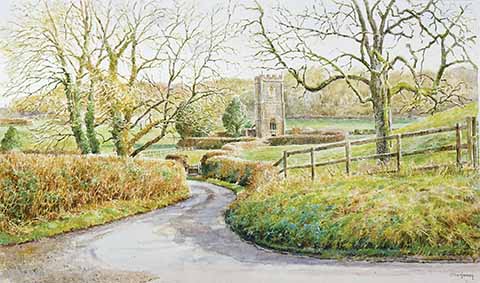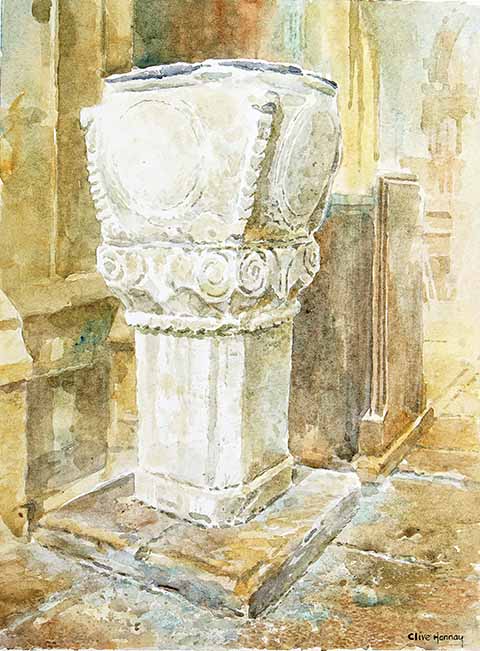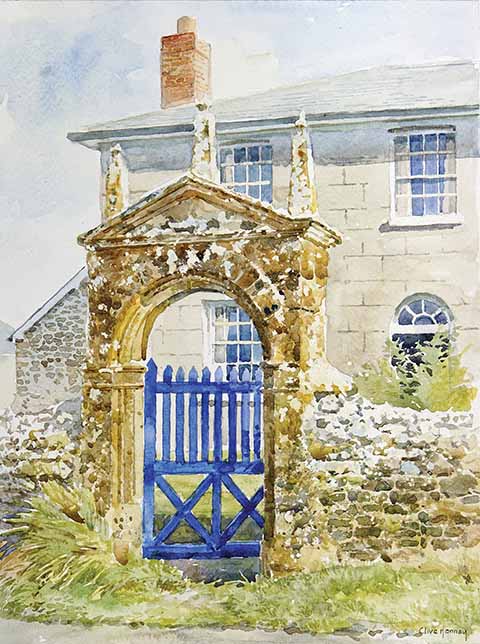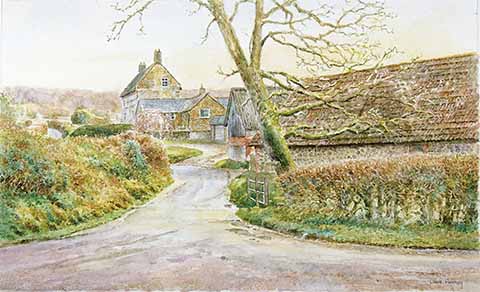Clive Hannay village walk – Batcombe
Clive Hannay in a village where the Dorset Downs fall away into the Blackmore Vale
Published in May ’19
 Batcombe’s most famous historical resident was a 17th-century member of the family that provided the lords of the manor from 1570 to 1705, ‘Conjurer’ Minterne. A conjurer was the closest an English village of that period had to a witch doctor: he was not necessarily a malevolent presence, but would cure illnesses in humans and – almost as important – animals by spells and incantations.
Batcombe’s most famous historical resident was a 17th-century member of the family that provided the lords of the manor from 1570 to 1705, ‘Conjurer’ Minterne. A conjurer was the closest an English village of that period had to a witch doctor: he was not necessarily a malevolent presence, but would cure illnesses in humans and – almost as important – animals by spells and incantations.
One day, Minterne rode off towards Dorchester but had no sooner reached the ridge of Batcombe Hill when he remembered that he had left his magic book open on his study table. Anxious to get back as swiftly as possible before his servants could read the book, he launched his steed in a mighty leap off the hill and down to the village. In his flight, he knocked one of the pinnacles off the church tower. For fear of offending the Devil, the villagers left it unrepaired for a hundred years, and when it was re-installed, it was at a crooked angle. The villagers regarded their fears as confirmed when the grass died and failed to re-grow on the spot where the intrepid equestrian aviator landed.
If one was going to attempt the impossible feat that legend attributes to Minterne, Batcombe would not be a bad place to choose. Batcombe Hill, part of the great chalk escarpment of the Dorset Downs, rears up immediately to the south of the church to provide a launching pad; this marks the boundary of the Blackmore Vale, which stretches away to the north and provides spectacular views not only from the hill but from the fields surrounding the village.
 The parish church whose embellishments Minterne treated so cavalierly stands on a site where there has been a church since the 11th century. The limestone basin and Ham Hill column of the font date from Norman times. The tower is 15th-century and perhaps the most striking feature of the interior is a most elegant Ham Hill stone screen. The church was rebuilt in 1864 by John Hicks, architectural mentor to Thomas Hardy, who had left him a couple of years earlier to seek his fortune in London. A casualty of the re-building was the tomb of our old friend, ‘Conjurer’ Minterne. In keeping with his eccentric nature, he had demanded to be buried neither in the church nor in the graveyard, so his tomb was in the wall of the Minterne chapel, which Hicks did away with. Is this where Anthony Ettricke got the idea from for his more famous tomb in Wimborne Minster, which is similarly within the wall? Minterne memorial tablets survive on the north wall of
The parish church whose embellishments Minterne treated so cavalierly stands on a site where there has been a church since the 11th century. The limestone basin and Ham Hill column of the font date from Norman times. The tower is 15th-century and perhaps the most striking feature of the interior is a most elegant Ham Hill stone screen. The church was rebuilt in 1864 by John Hicks, architectural mentor to Thomas Hardy, who had left him a couple of years earlier to seek his fortune in London. A casualty of the re-building was the tomb of our old friend, ‘Conjurer’ Minterne. In keeping with his eccentric nature, he had demanded to be buried neither in the church nor in the graveyard, so his tomb was in the wall of the Minterne chapel, which Hicks did away with. Is this where Anthony Ettricke got the idea from for his more famous tomb in Wimborne Minster, which is similarly within the wall? Minterne memorial tablets survive on the north wall of
the tower.
The church hit the local headlines as recently as 1974. It originally had four bells, but one was sold to pay for the 1864 re-building and two others were melted down and used to cast a new bell in 1958. Parish funds did not run to hanging this and the one surviving original bell (cast in 1592). They were displayed in the nave but in 1974 they were stolen, presumably for their scrap value. A few days later, an alert policeman, PC Ball, stopped a van near Ringwood because it was right down on its springs and was obviously carrying an unusually heavy load. Indeed it was: the Batcombe bells. The new bell was immediately hung in the ringing chamber (the older one was cracked) and was rung for the first time later that same year at a Thanksgiving Service attended by PC Ball.
 The Minternes’ manor house was at Newlands Farm, which retains an archway over its front gate with a datestone of 1622, although the present house behind it is at least 200 years younger than that. In the southern part of the village, just north of the church, several cottages are constructed of clunch, a sort of hard chalk. Not uncommon in eastern England (it was used in the interior of Ely Cathedral), it is less often found in Dorset, and its presence here is no doubt explained by the proximity of the chalk of Batcombe Hill.
The Minternes’ manor house was at Newlands Farm, which retains an archway over its front gate with a datestone of 1622, although the present house behind it is at least 200 years younger than that. In the southern part of the village, just north of the church, several cottages are constructed of clunch, a sort of hard chalk. Not uncommon in eastern England (it was used in the interior of Ely Cathedral), it is less often found in Dorset, and its presence here is no doubt explained by the proximity of the chalk of Batcombe Hill.
In the parish of Batcombe but detached from the village itself is Hilfield Friary, a Franciscan community. Originally a farmhouse, it was bought by the Earl of Sandwich as a shooting lodge.
 His nephew, the ninth Earl, was much taken by the theories of Homer Lane, who believed that the way to deal with delinquent children was not to punish them but to give them greater responsibility for themselves and within the community.
His nephew, the ninth Earl, was much taken by the theories of Homer Lane, who believed that the way to deal with delinquent children was not to punish them but to give them greater responsibility for themselves and within the community.
In 1913 the ninth Earl set up the Little Commonwealth at Hilfield, run by the children and overseen by Homer Lane, but rumours about Lane’s misconduct with his charges proved fatal. Immediately after World War 1, the site became an agricultural training centre for ex-servicemen before the Franciscans arrived in 1921. Initially tenants, they bought the freehold from the ninth Earl in 1957.
A strange use of the village’s name is recorded by J S Udal in his Dorsetshire Folklore, where he says that ‘Batcombe boys’ was a synonym for women, as in ‘You’ve got a good lot of Batcombe boys helping you with the haymaking.’ There is a village of the same name in Somerset, some 25 miles to the north: could the expression have come from there?
THE WALK
Start by the church of St Mary Magdalene for a walk of some 2¼ miles, mostly on village lanes; where the walk leaves the lanes, remember this is the Blackmore Vale, so be prepared for mud. If you are coming from the south, the church is at the bottom of the steep gradient from the Evershot to Minterne Magna road, on the right at the start of the village.
Walk up the lane in the same direction, passing some of Batcombe’s scattered farms and dwellings. At a T-junction in about 1100 yards, turn right and almost immediately left, signed to Leigh. In about 275 yards pass Newlands Farm with its distinctive arch, and turn right at the end of its front wall, into a yard. Cross the yard, go through a kissing gate and walk straight across the field beyond.
Go through an opening, across a stream and up a short slope into the next field, where bear slightly right over the brow of the field to the far right-hand corner. Here continue along a broad grassy path to a gate and follow the right-hand edges of the next two fields. On the far side of the second, narrow field cross a double stile and turn right to follow the right-hand field-edge. In about 200 yards there is a stile on the right. If it is very overgrown, as it was when we did the walk, continue for 150-200 yards to another stile.
Cross one of these stiles and turn left. Follow the field-edge as it curves to the right and reaches a gate, go through this and bear slightly right to cross the field beyond to the far right-hand corner. Here, go through a gate on the right, up a short track and through another gate to reach a lane. Turn right and walk down to the junction, where turn left then left again to walk back to your car.

